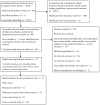Dietary factors and type 2 diabetes in the Middle East: what is the evidence for an association?--a systematic review
- PMID: 24077241
- PMCID: PMC3820049
- DOI: 10.3390/nu5103871
Dietary factors and type 2 diabetes in the Middle East: what is the evidence for an association?--a systematic review
Abstract
This review aims to search and summarise the available evidence on the association between dietary factors and type 2 diabetes mellitus (T2DM) in Middle Eastern populations, where diabetes prevalence is among the highest in the world. Electronic databases were searched; authors, libraries, and research centres in the Middle East were contacted for further studies and unpublished literature. Included studies assessed potential dietary factors for T2DM in Middle Eastern adults. Two reviewers assessed studies independently. Extensive searching yielded 17 studies which met the inclusion criteria for this review. The findings showed that whole-grain intake reduces the risk of T2DM, and potato consumption was positively correlated with T2DM. Vegetables and vegetable oil may play a protective role against T2DM. Dietary patterns that are associated with diabetes were identified, such as Fast Food and Refined Grains patterns. Two studies demonstrated that lifestyle interventions decreased the risk of T2DM. In summary, the identified studies support an association between some dietary factors and T2DM; however, many of the included studies were of poor methodological quality so the findings should be interpreted with caution. The review draws attention to major gaps in current evidence and the need for well-designed studies in this area.
Figures
References
-
- Shaw J.E., Sicree R.A., Zimmet P.Z. Global estimates of the prevalence of diabetes for 2010 and 2030. Diabetes Res. Clin. Pract. 2009;87:4–14. - PubMed
-
- Willett W.C. Nutritional Epidemiology. 2nd ed. Oxford University Press; New York, NY, USA: 1998. pp. 50–74.
Publication types
MeSH terms
LinkOut - more resources
Full Text Sources
Other Literature Sources
Medical
Miscellaneous


